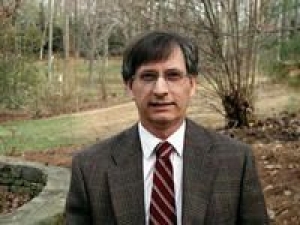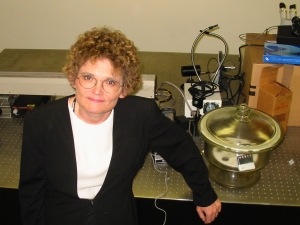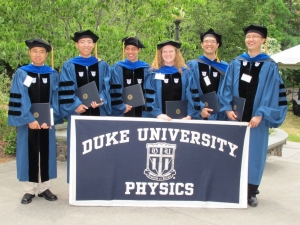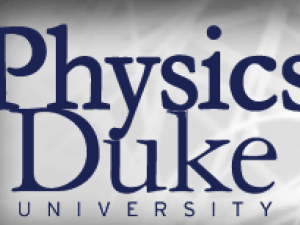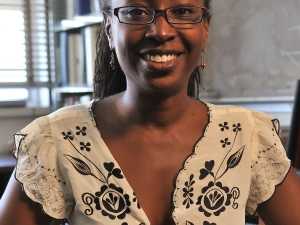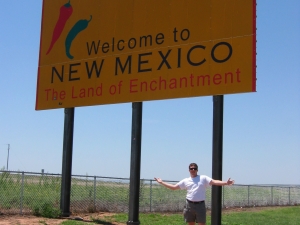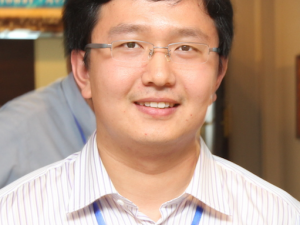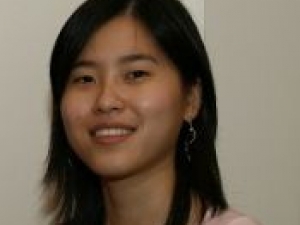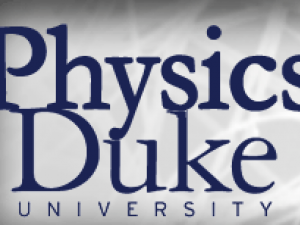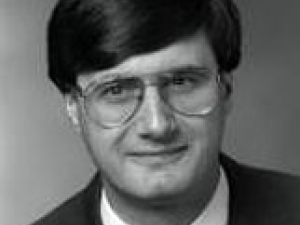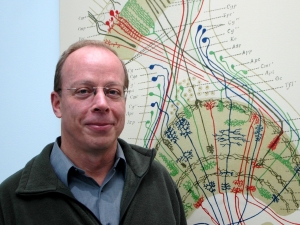Alexander Tuna (Trinity 2010) was awarded the 2010 Daphne Chang Memorial Award for undergraduate research in the Duke Physics Department. The award is in honor of Daphne Y. Chang (Trinity 2005), a Duke Physics Major, who passed away in 2009 at the age of 26 and who is remembered for her remarkable success in undergraduate research. Alexander, under the supervision of Prof. Christopher Walter, designed an analysis to search for fractionally charged particles in the… read more about 2010 Daphne Chang Memorial Award awarded to Alexander Tuna »
Congratulations to the Dorff family! Peter James (Pete) was born on Monday, May 17 at 8:46pm to Jimmy Dorff, Physics IT Senior Manager at Duke Physics, and his wife Jenn. read more about Welcome Baby Dorff! »
Physics Department alumna Colleen Fitzpatrick was featured in the magazine More: For Women of Style andSubstance in an article called "The DNA Detective," written by Lynne Rosselini. Read the story online here. Fitzpatrick graduated with a PhD in Physics in 1983. Please see our April Alumni Profile on Fitzpatrick here and our Flickr album that focuses on her work and travels. read more about Alum Colleen Fitzpatrick, The DNA Detective »
Prof. John Thomas had an article, "The nearly perfect Fermi gas," published in the May 2010 issue of Physics Today. There are also two inter-related articles by other authors, forming a "special focus" issue on perfect fluids. To read the full articles, you must log in with a Physics Today account. Read Thomas' article online here. See the first paper here and the third here. read more about Prof. John Thomas featured in Physics Today »
“I shine a light on things for a living,” says Colleen Fitzpatrick, PhD ’83. This simple statement covers Fitzpatrick’s wildly varying experiences since graduating, including building an optical laboratory in her garage, starting her own laser and optics company, and most recently, using “forensic genealogy” and DNA analysis to locate missing people, identify remains, and solve historical mysteries. How can one person find success both as a physicist and as an expert in identifying remains and tracking… read more about Alumni Profile - From Physics to Forensic Genealogy »
Logo credit to CERNThis Spring, Duke Physics students have been recognized for their excellence in research and ambition. Read the following profiles to see what they will be up to this summer and fall. The student research projects will involve travel to Fermilab in Illionois, LAL in France, and the LHC in Geneva. Several students will be working with data from the ATLAS experiment at the LHC. View Photos of the students and their research areas on… read more about Student Research Awards »
Duke awarded 6 doctorate degrees to physics students in the Spring of 2010. Congratulations to all recently minted PhDs, and good luck on all of your endeavors! The recent PhDs' research varies across the field of physics sub-disciplines. View their photos here. read more about May 2010 Graduation »
Duke physicists played a major role in the recent direct exclusion of Higgs bosons at Fermilab’s Tevatron, which was featured on the cover of the February 12, 2010, issue of Physical Review Letters (PRL). Duke professor Mark Kruse says the study excluded the 162-166 GeV/c2 range of masses for the Standard Model Higgs boson using direct searches for the Higgs in a W+W- decay process. Kruse says his graduate student Dean Hidas, PhD 2009, did a large part of the work that led to the exclusion… read more about Department Research Update - Higgs Exclusion at Tevatron Gets Noticed »
Duke’s Arts and Sciences Council recently approved a request from the physics department to create a new major in biophysics. The major will be administered by the physics department in close collaboration with the departments of biology, chemistry, and biomedical engineering. As Director of Undergraduate Studies, physics professor Seog Oh led the effort to create the new major. He says he had been hearing from undergrads for some time that they were interested in exploring the interface between physics and… read more about Department Update - A New Major at Duke: Biophysics »
The Duke Physics department had a strong presence at both the March and April 2010 meetings of the American Physical Society. Among the many contributed talks by Duke scholars at the March meeting were two invited talks. Prof. Harold Baranger and Yang Yang, a Duke PhD student, were invited to speak. At the April meeting four faculty speakers from Duke were invited to give a talk on their research - Prof. Roxanne Springer, Prof. Ayana Arce, Prof. Chris Walter,… read more about Department Update - Duke Physicists Give Invited Talks at the 2010 APS Meeting »
NOTE: LINKS HAVE BECOME BROKEN DUE TO SITE REDESIGN As the 2009-2010 school year comes to a close, it's time to look back at a year of achievements and progress among faculty, staff, graduate students, and undergraduates. Faculty and students have participated in research collaborations all over the world and have continued to win research grants, fellowships, and awards. We've presented our work in physics journals and international meetings, and we've been covered by the media. We've also developed a new graduate… read more about Welcome to the April Duke Physics Newsletter »
Professor Moo-Young Han is back from a sabbatical semester at Seoul National University in Korea. He taught undergraduate and graduate-level physics classes, and spent a great deal of time theorizing about particle physics with his colleague and old friend Jihn E. Kim. “He and I work in the same area,” Han says. “He is the foremost theorist in Korea.” Kim and Han were doing what every theoretical particle physicist in the world is doing right now: “Basically making bets about what might happen at the Large… read more about Faculty Research Update: Moo-Young Han’s Sabbatical in Korea »
Duke Physics Alumni have gone on to succeed in incredibly diverse career paths. We've collected the destinations for Duke Physics alumni from the past 18 years and included them in a word cloud. Check out the full-page image of the Duke Alumni Career Cloud at Wordle.net: read more about Duke Physics Alumni - Career Word Map »
The photo above is an image taken by the Hubble Space Telescope of a nearby spiral galaxy with a globular cluster marked and enlarged.Jay Strader, ’02, was an economics and math major when he took an astrophysics course as a sophomore. The course, taught by former Duke professor John Kolena, captured his imagination in a way economics never had, and a summer research project related to old massive star clusters convinced him to drop the econ major and replace it with physics (he kept the… read more about Jay Strader, Hubble Fellow at the Harvard-Smithsonian »
NOTE: LINKS HAVE BECOME BROKEN DUE TO SITE REDESIGN Duke Physics' Graduate Curriculum Committee adopted a new Graduate Program curriculum in October 2009. This committee, composed of faculty members and graduate students, conceived of an exciting redirection of the graduate program that offers incoming students the ability to focus on their own research while taking challenging courses. Read details on the new curriculum at the Duke Physics website. read more about New Curriculum in Graduate Program »
Josh Albert, a fourth-year graduate student at Duke, recently returned from another trip to a high energy physics experiment in Japan. "The travel is fascinating," Albert says. "Not just from a physics perspective but also because I'm able to meet people with such different perspectives." High energy physics experiments are massive endeavors, requiring teams of hundreds or thousands of physicists from dozens of countries. Graduate students and undergrads at Duke are active participants in these… read more about High Energy Physicists as World Travelers »
The physics department’s newest faculty member, Ayana T. Arce, earned her PhD at Harvard, did a Chamberlain post-doctoral fellowship at Lawrence Berkeley National Laboratory, and is thrilled to have settled at Duke. As a high energy experimental physicist, Arce has worked with a lot of different physics departments at Fermilab and the Large Hadron Collider. “Each department has their own flavor,” she says. “High energy physics at Duke has got a perfect combination of energy and healthy collegial spirit.”… read more about Ayana Arce: HEP's Newest Faculty Member »
Why Duke Physics? A Photo Essay on the Strengths of DukeThe collage below is a selection of our ongoing photo essay called "Why Duke Physics?" This project, hosted at both Flickr and Facebook, collects quotes and images that cover the variety of aspects that draw students to the Duke Physics Department. What better way to highlight our strengths than to ask members of the Duke Physics community? Become a Fan of Duke Physics on Facebook Duke Physics is now on… read more about Connect to Duke Physics on the Web! »
NOTE: LINKS HAVE BECOME BROKEN DUE TO SITE REDESIGN Students who have been accepted to the Duke Physics graduate program are just now finding congratulatory emails in their inboxes. Many of you alumni will remember the feelings of excitement when choosing to attend Duke. This issue highlights the diverse experiences in physics research available at Duke. These strengths come from cutting-edge faculty, state-of-the-art research facilities, a strong global presence, and an enriching graduate community. Our… read more about Welcome to the February Duke Physics Newsletter »
Xin Qian, a graduate student in Prof. Haiyan Gao’s Medium Energy Physics Group, is the winner of the 2010 Caltech Prize Fellowship in Experimental Physics or Astrophysics. The Fellowship is highly competitive. For the fall of 2010, Xin Qian is the only candidate in the world who has been awarded this prize Fellowship. According to the Fellowship webpage: "This Fellowship program has been established to offer scientists, typically within a few years after receipt of the Ph.D., the… read more about Xin Qian Wins 2010 Caltech Postdoctoral Prize Fellowship »
In Memoriam - Daphne Y. Chang (Trinity 2005), a Duke Physics major, passed away on December 21st after battling a never fully diagnosed disease on and off for the past two years. She was 26 years old. Daphne will be remembered by the Duke Physics community as an extraordinary person: in her sophomore year she joined the Nuclear Theory Group as an independent study student. Her subsequent research under the supervision of Prof. Steffen A. Bass on the production of strange quarks in relativistic heavy-ion… read more about Daphne Chang Memorial Award Fund »
Duke professors Berndt Mueller and Steffen Bass are playing leading roles in a multi-institutional team that was recently awarded Department Of Energy (DOE) funding for a Topical Collaboration on "Jet and Electromagnetic Tomography in Heavy-Ion Collisions." The JET Collaboration, which includes theorists from eight institutions in the U.S. and Canada, was among the first three topical collaborations in nuclear theory to be awarded in this new program of the DOE Office of Science. Mueller… read more about Profs. Mueller and Bass awarded Topical Collaboration Grant »
Duke Physics is now on Facebook and Filckr, a photo sharing community. These sites provide new ways of connecting to the Duke Physics community of professors, alumni, students and physics-enthusiasts around the globe. Click on either image to see our activities on the web. Most of the photos on Flickr are submitted by members of the Duke Physics Community. Do you have photos you'd like to share? There are two easy ways to share your photos:Submit images directly to our Flickr page in an email to "… read more about Connect to Duke Physics on the Web! »
NOTE: LINKS HAVE BECOME BROKEN DUE TO SITE REDESIGN We have added two new sections to the Duke Physics News Site: Duke Physics In the News is a collection of notes referring to mentions of Duke Physics in the media, and Department Achievements is a list of brief news items about people from the department. read more about Duke Physics In the News & Department Achievements »
Prof. Daniel Gauthier (Duke Physics) and Prof. Robert Boyd (Institute of Optics, University of Rochester) have just been awarded a grant to study quantum communication protocols that encode information in the transverse profile of an optical beam. Specifically, they are investigating encoding information in the orbital angular momentum degrees of freedom of a beam, with the goal of reliable transmission of more than one bit of information per photon. Also, they are investigating whether these protocols are… read more about Faculty Research Update - Gauthier and Boyd receive Grant for Quantum Communication Study »
Duke Professor Henry Greenside is a theoretical physicist who studies how the brain works. He says, “The brain is so complicated we need to approach it from various angles. The thing a physicist brings to bear is the belief that if you push hard enough there will be some understanding. Physicists use theoretical and mathematical tools and we’ve repeatedly found concise mathematical descriptions of very complicated things.” Greenside spent the fall term on sabbatical at Janelia Farm, the research campus of… read more about Faculty Research Update - Physicist as Brain Scientist »
As a graduate student at TUNL, Scott Wilburn '93 made precision measurements with neutrons in order to study the interactions of polarized neutrons and polarized protons. Today, he’s using similar techniques at the Los Alamos National Laboratory in New Mexico, but with lower-energy neutrons, and with a different goal. “I’m using the neutron as a laboratory to look for new physics beyond the standard model,” he says. “The neutron decay process is interesting to look at because you can do both very precise measurements and… read more about Alumni Profile - Scott Wilburn at Los Alamos National Laboratory »
Professor Mark Kruse spent November 29-December 3 at the Large Hadron Collider at CERN in Geneva. “The atmosphere there is pretty incredible right now,” he says. “Everyone’s getting very excited. The beam is circulating and they’ve managed to produce proton-proton collisions in the last few days—at a lower energy than designed, but still a huge milestone toward that goal.” Now that the LHC is operational again, thousands of scientists, engineers, and students have converged on the place. “There are… read more about Department Research Update - Duke Physicists at the LHC »
NOTE: LINKS HAVE BECOME BROKEN DUE TO SITE REDESIGN With this issue we are announcing Duke Physics' new online presence on what some term "the social web" - the collection of websites (like Facebook, Flickr, and LinkedIn) where hundreds of millions of people across the world connect through common interests. This type of online networking is important for Duke Physics, as the department's academic and professional connections are global in scope, and given our objectives of broadening awareness about the… read more about Welcome to the December Newsletter for Duke Physics »
Duke Physics attracts students and researchers from all over the world. In fact, Duke Physics graduate students represent 17 countries. Five years ago, two Chinese graduate students saw a need to offer support and information to other Chinese students considering Duke—not just for physics studies, but for any subject. Wei Chen and Xing Zong, both PhD students at TUNL, set up www.dukechina.org to provide information to prospective students, current students, alumni, faculty, and visiting scholars about everything… read more about Graduate Student News - Physics Grad Students Create DukeChina.org »


